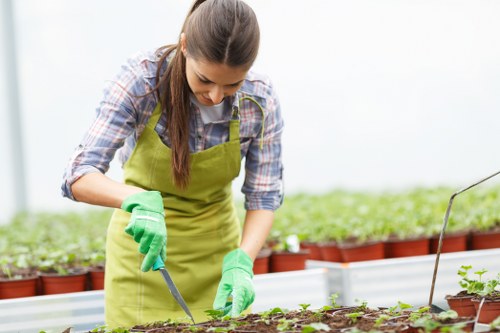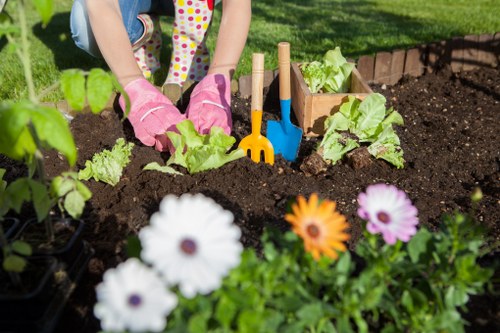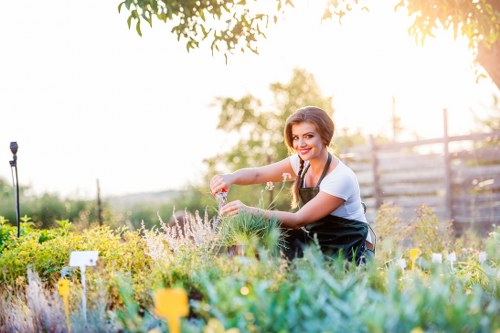Gardener Cranford: Your Ultimate Guide to Thriving Gardens

Introduction to Gardener Cranford
Gardener Cranford is your go-to source for all things related to gardening in Cranford. Whether you're a seasoned green thumb or just starting, understanding the unique aspects of gardening in this area can help your plants thrive. Cranford offers a diverse climate and soil conditions that can affect your gardening success, making it essential to have tailored advice and resources.
In this guide, we'll delve into the best practices for gardening in Cranford, explore the types of plants that flourish here, and provide tips on maintaining a beautiful and sustainable garden. Let's embark on this green journey together!
Gardening in Cranford is more than just planting flowers and vegetables; it's about creating a harmonious environment that supports local wildlife, conserves water, and promotes biodiversity. With the right knowledge and tools, you can transform your outdoor space into a vibrant and productive garden.

Understanding Cranford's Climate and Soil
To be a successful gardener in Cranford, it's crucial to understand the local climate and soil composition. Cranford experiences a temperate climate with distinct seasons, including cold winters and warm summers. This climate influences the types of plants that can thrive and the gardening techniques that are most effective.
The soil in Cranford varies, but it is generally a mix of clay and loam. Clay soils retain moisture well but can become compacted, making it harder for roots to grow. Loam soils are more balanced, providing good drainage while retaining essential nutrients. Conducting a soil test can help determine the specific needs of your garden, such as pH levels and nutrient content.
By understanding these environmental factors, you can choose the right plants and amend your soil appropriately to create the ideal growing conditions for your garden.

Top Plants for Cranford Gardens
Selecting the right plants is key to a thriving garden in Cranford. Here are some of the top choices that perform well in this region:
- Perennials: Plants like black-eyed Susans, coneflowers, and hostas offer long-lasting beauty and require minimal maintenance.
- Vegetables: Tomatoes, peppers, and lettuce are popular choices that can be grown successfully with proper care.
- Herbs: Basil, rosemary, and thyme are excellent for both culinary use and as attractive additions to your garden.
- Native Plants: Incorporating native species like the New Jersey tea plant and bee balm supports local ecosystems and reduces the need for extra watering and fertilizing.
Choosing a mix of these plants can create a diverse and resilient garden that thrives throughout the year.

Gardening Techniques for Cranford
Implementing the right gardening techniques can make a significant difference in the health and productivity of your Cranford garden. Here are some effective methods to consider:
- Mulching: Applying a layer of mulch helps retain soil moisture, suppress weeds, and regulate soil temperature.
- Composting: Creating compost enriches your soil with essential nutrients and improves its structure.
- Drip Irrigation: This efficient watering system ensures that plants receive the right amount of water directly to their roots, conserving water and reducing evaporation.
- Crop Rotation: Rotating your crops each season prevents soil depletion and reduces the risk of pests and diseases.
By incorporating these techniques, you can enhance the sustainability and productivity of your garden.

Local Resources and Community
Gardener Cranford is part of a larger community that values green spaces and sustainable practices. Here are some local resources and community initiatives that can support your gardening efforts:
- Cranford Botanical Garden: A local hub for gardening enthusiasts, offering workshops, plant sales, and educational programs.
- Neighborhood Composting Programs: Join community composting efforts to reduce waste and create rich soil for your garden.
- Garden Clubs: Connect with fellow gardeners through local garden clubs to share tips, seeds, and experiences.
- Local Nurseries: Support local businesses by purchasing plants and gardening supplies from Cranford nurseries.
Engaging with these resources can provide valuable support and inspiration for your gardening projects.
Maintaining Your Cranford Garden
Maintaining a garden in Cranford requires regular attention and care. Here are some essential maintenance tips:
- Regular Weeding: Keep your garden free of weeds to reduce competition for nutrients and water.
- Pruning: Trim overgrown plants and remove dead or diseased branches to promote healthy growth.
- Pest Management: Monitor your plants for signs of pests and diseases, and use eco-friendly treatments when necessary.
- Soil Health: Continuously monitor and amend your soil to ensure it remains fertile and well-structured.
By staying on top of these maintenance tasks, you can ensure your garden remains vibrant and productive throughout the seasons.
Sustainable Gardening Practices
Sustainability is a key aspect of modern gardening, and Cranford is no exception. Here are some sustainable practices to incorporate into your gardening routine:
- Water Conservation: Use rain barrels and efficient irrigation systems to minimize water usage.
- Organic Gardening: Avoid synthetic fertilizers and pesticides, opting instead for natural alternatives.
- Native Plant Selection: Choose native plants that are adapted to the local climate and require less maintenance.
- Composting: Recycle kitchen and garden waste to create nutrient-rich compost for your plants.
Implementing these practices not only benefits your garden but also contributes to the overall health of the environment.
Gardening Tools and Equipment
Having the right tools can make a significant difference in your gardening experience. Here are some essential tools for a Cranford garden:
- Hand Trowel: Perfect for planting, transplanting, and digging small holes.
- Pruning Shears: Ideal for trimming and shaping plants.
- Gardening Gloves: Protect your hands from thorns, dirt, and other hazards.
- Watering Can or Hose: Ensure your plants receive adequate water.
- Wheelbarrow: Useful for transporting soil, compost, and other materials.
Investing in quality gardening tools can enhance your efficiency and enjoyment while working in your garden.
Local Regulations and Guidelines
Before embarking on your gardening projects, it's important to be aware of local regulations and guidelines in Cranford. These may include:
- Zoning Laws: Understand any restrictions related to garden size, fencing, or plant types.
- Water Usage Regulations: Be aware of any limitations on water usage, especially during drought conditions.
- Environmental Protection: Ensure your gardening practices comply with local environmental protection standards.
- Permit Requirements: Some projects, such as building structures or extensive landscaping, may require permits.
Compliance with these regulations ensures that your gardening efforts are both legal and environmentally responsible.
Seasonal Gardening Tips
Gardening in Cranford involves adapting to the changing seasons. Here are some tips for each season:
Spring
- Prepare your soil by adding compost and fertilizers.
- Plant annuals and perennials that bloom in the summer.
- Start seeds indoors for vegetables that need a longer growing season.
Summer
- Ensure consistent watering, especially during hot and dry periods.
- Mulch your garden to retain moisture and suppress weeds.
- Monitor for pests and diseases, and take action as needed.
Fall
- Plant bulbs for spring flowering.
- Clean up garden debris to prevent overwintering pests.
- Prepare your garden beds for winter by adding organic matter.
Winter
- Protect sensitive plants with coverings or bring them indoors.
- Plan your garden layout and order seeds for the upcoming year.
- Maintain your gardening tools to ensure they're ready for spring.
Gardener Cranford's Commitment to Quality
Gardener Cranford is dedicated to providing high-quality resources and support to the local gardening community. Our mission is to empower gardeners with the knowledge and tools they need to create beautiful, sustainable gardens. We believe that gardening is not just a hobby, but a way to connect with nature, improve well-being, and contribute to a healthier environment.
Through our comprehensive guides, community initiatives, and expert advice, we strive to make gardening accessible and enjoyable for everyone in Cranford.
10-15 Nearby Areas to Cranford for Gardening Enthusiasts
Cranford is surrounded by several nearby areas, each offering unique features for gardeners:
- Bridgewater: Located just north of Cranford, Bridgewater boasts numerous public gardens and parks perfect for gardening inspiration.
- Garwood: A short drive east, Garwood offers community gardening plots and local plant nurseries.
- Roselle: Southwest of Cranford, Roselle is known for its botanical gardens and gardening workshops.
- Westfield: Northwest of Cranford, Westfield has expansive green spaces and expert-led gardening classes.
- Linden: Northeast of Cranford, Linden features organic farms and sustainable gardening initiatives.
- Morris: West of Cranford, Morris offers specialty plant shops and extensive garden centers.
- Bloomfield: Southeast of Cranford, Bloomfield is home to community-supported agriculture and garden clubs.
- Fanwood: East of Cranford, Fanwood provides historical gardens and eco-friendly gardening resources.
- Edgewater: Southwest, Edgewater has waterfront gardens and unique plant varieties.
- Union: North, Union offers integrated pest management resources and urban gardening projects.
- Elizabeth: South, Elizabeth features diverse plant communities and local gardening events.
- Kenilworth: West, Kenilworth has private garden tours and professional landscaping services.
- Garwood: Nearby, Garwood supports small-scale gardening and community green spaces.
- Clark: Southeast, Clark offers innovative gardening techniques and garden-to-table programs.
- Basking Ridge: Northwest, Basking Ridge has historic gardens and heritage plant varieties.
Each of these areas provides valuable resources and unique opportunities for gardeners, making them excellent destinations for those looking to expand their gardening horizons.
Conclusion
Gardener Cranford is your comprehensive resource for creating and maintaining a flourishing garden in the unique environment of Cranford. By understanding the local climate and soil, selecting the right plants, employing effective gardening techniques, and utilizing community resources, you can achieve a beautiful and sustainable garden. Embrace the joy of gardening and contribute to the green beauty of Cranford and its surrounding areas.
FAQs
1. What are the best times to plant in Cranford?
The best times to plant in Cranford are during the spring and early fall. Spring planting allows plants to establish before the heat of summer, while early fall provides cooler temperatures that are ideal for root growth.
2. How can I improve the soil quality in my Cranford garden?
Improving soil quality can be achieved by adding compost, using organic fertilizers, and practicing crop rotation. Conducting a soil test can also help identify specific nutrient deficiencies that need to be addressed.
3. What native plants are recommended for Cranford gardens?
Native plants such as the New Jersey tea plant, bee balm, black-eyed Susans, and hostas are excellent choices for Cranford gardens. These plants are well-adapted to the local climate and support local wildlife.
4. How can I conserve water in my garden?
Water conservation can be achieved by using drip irrigation systems, applying mulch to retain moisture, collecting rainwater, and choosing drought-resistant plants that require less watering.
5. Are there any local gardening clubs or communities in Cranford?
Yes, Cranford has several gardening clubs and community initiatives. Joining these groups can provide you with valuable resources, support, and opportunities to connect with fellow gardening enthusiasts.

